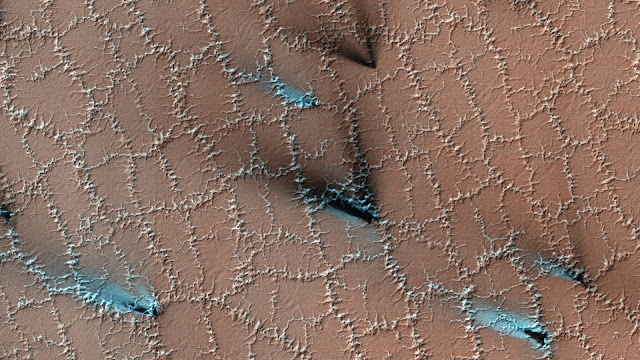Strange cracks called "polygons" can be seen in the Martian surface
Is it a sign of spring or an alien infrastructure?
A new image from the High Resolution Imaging Experiment (HIRISE) camera shows that the mysterious polygons are blooming on Mars this spring.
White zigzags crack the Martian soil at high latitudes in this image taken on March 30, 2022. Sprays of black and blue mist fan out between the white zigzags. Martian spring is characterised by zig-zags and colourful sprays caused by subterranean ice reservoirs bumping up against the dry Martian surface, researchers at the University of Arizona, which oversees the HIRISE mission, wrote in a statement released on Monday (June 20).
According to a study, water and dry ice play a significant role in shaping the surface of Mars at high latitudes." Polygons are formed by water ice embedded in the soil.
Surface ice sublimation causes the edges of these polygons to crack and fray in the springtime, when ice melts into a gas. Dry ice vents shoot out of the Martian surface when this transformation takes place, leaving dark, fan-shaped deposits of particles on the ground, according to the researchers. The ground is marked by bright whitish-blue streaks where dark particles have sunk back into the dry ice.
Open and close multiple times depending on the wind, an ice vent can spray particles in different directions on Mars' surface. As a result, you'll see multiple light and dark streaks protruding from a single vent in some areas. The seasonal expansion and contraction of ice can cause the fans and polygons to slowly warp the Martian landscape over time.
NASA's Mars Reconnaissance Orbiter, which launched in 2006, carries the HIRISE camera. There have been a number of strange and amusing images captured by this orbiter over the past few decades. A rock and crater formation near the Martian south pole, for example, looked exactly like the bug-eyed Muppet Beaker when it was seen by the orbiter last year.
Sponsored Links:
- Wonder
Leaf CBD Oil
- Wonder Leaf
CBD Oil Reviews
- Wonder
Leaf CBD Oil USA Customer Reviews
- Wonder Leaf CBD Oil USA Reviews
Details:
https://techplanet.today/post/wonder-leaf-cbd-oil-2022
https://www.facebook.com/Wonder-Leaf-CBD-Oil-110124458422628
It's hard to overstate how stunning the images of Valles Marineris, our solar system's largest canyon, are (and therefore the largest known canyon in the universe). Even though it's three times longer and three times deeper than Earth's Grand Canyon, the canyon's formation on Mars is still a mystery to geologists. If there were any Muppets involved, they're keeping quiet.
Water Ice and CO2 Seem to Have Created a Weird Honeycomb Pattern on Mars
At high latitudes on Mars, dry ice is a major factor in shaping the planet's surface, according to scientists from HiRISE.
Water ice that has formed in the soil has split it into polygonal forms. When the ground warms in the spring, dry ice sublimating from just beneath the surface causes even more erosion, resulting in channels around the polygonal boundaries.Seasonal changes in the thickness of the near-surface ice cause the polygons to form over time.
However, the blue fan-shaped features in this polygon-covered region show even more springtime activity. As the layer of translucent dry ice that covers the surface grows, scientists believe that gas can be released.
HiRISE researchers wrote on the HiRISE website that "the gas transports fine particles from the surface, further eroding the channels."
"Particles fall to the ground in fan-shaped deposits that are dark in colour. Dark particles may sink into the dry-ice and leave bright marks where the fans were originally placed. When the wind changes, the vent may close and then reopen, resulting in multiple fans blowing in different directions from the same location."
News Source: https://www.livescience.com/mars-polygons-ice-sublimation
You may like to read the following news as well :
- Dr. Oz wins Republican Pennsylvania Senate primary
- Illinois’ COVID-19 case rate, hospitalizations decline
- Can the SEC stand up to the richest man on the planet?




Comments
Post a Comment